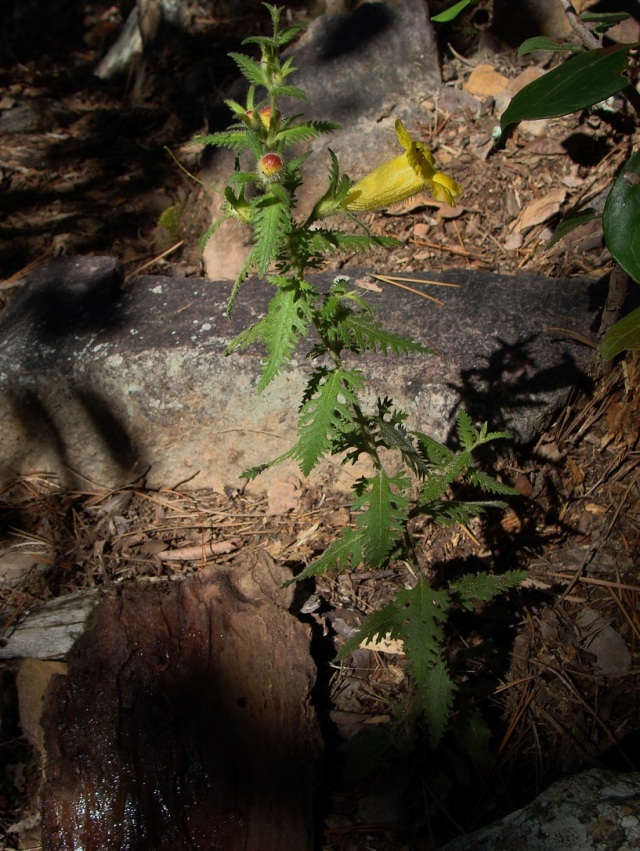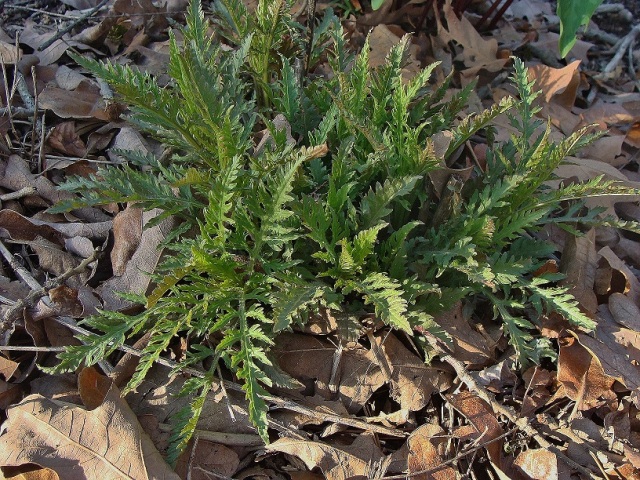Comb-Leaf Yellow False Foxglove and Smooth Yellow False Foxglove
Comb-leaf yellow false foxglove (Aureolaria pectinata) and smooth yellow false foxglove (Aureolaria flava) are hemiparasitic (obtain some nutrients from other plants) plants, but do also have chlorophyll and perform photosynthesis. These yellow false foxgloves attach to oak tree roots via haustoria (modified roots that penetrate the host’s tissues). They are sometimes also called “oak leaches” for this reason. Previously placed in the traditional Scrophulariaceae (Figwort) Family, the yellow false foxgloves and other hemiparasitic species have since been transferred to the Orobanchaceae (Broom-rape) Family. The genus name “Aureolaria” in Latin refers to the golden-yellow flowers of these species.
Plant color is medium green for yellow false foxgloves, and leaves and flowering branches are opposite. Leaves, flowering branches and flowers grow from leaf axils. Trumpet-shaped and canary-yellow flowers, occurring in late summer to early fall, are solitary on short pedicels. The corollas have five rounded spreading lobes (two on top and three on bottom) that fuse to form a trumpet-shaped tube. Four overhanging stamens are fused to the bottom of the tube. A slender style from the superior ovary protrudes slightly beyond the grouped stamens. Ovoid seed capsules split when mature and dry.
Yellow false foxgloves are pollinated by bumble bees and hummingbirds. They are also larval host plants for the Baltimore checkerspot butterfly.
Comb-Leaf Yellow False Foxglove
Comb-leaf yellow false foxglove, an annual, occurs in the US from eastern Texas and Oklahoma to Missouri and eastward to the Atlantic Coast. In Arkansas, it is mainly found in highlands of the Ozark and Ouachita Mountains (including the mountains and ridges of the Arkansas Valley). Comb-leaf yellow false foxglove grows in sandy to rocky, open woodlands and glades in thin, dry, acidic soils. Young plants have a rosette of basal leaves which are elliptic to lance-like and entire (no indentions). Mature plants, up to three feet tall, may consist of a single main stem with minimal branching or a single stem with many branches. The plant is densely covered with glandular hairs and feels sticky to the touch. Leaves, generally 1.5” long and 0.75” wide with three to seven pinnate (feather-like) primary lobes, are deeply cut or comb-like (thus “pectinata” in the Latin name). Leaves are generally sessile except that lower leaves can be somewhat petiolate.
Photo 1: Spring growth of comb-leaf yellow false foxglove (an annual) showing simple basal leaves and pinnate leaves higher up-stem.
Photo 2: A single stemmed comb-leaf yellow false foxglove. Note dense hairs and reddish tip of flower buds.
Comb-leaf yellow false foxglove flowers August to September with blooms up to 1.5″ long and 0.75” wide. The calyx, formed by five pinnate sepals, is densely hairy as is the outside of flower buds and flowers. The ends of flower buds may be reddish and reddish streaks may occur along the lower-inside of the floral tube.
Photo 3: Stamens and style allow ample space for a bubble bee or hummingbird. Small bees, as shown, likely do not facilitate pollination.
Smooth Yellow False Foxglove
Smooth yellow false foxglove, a perennial, occurs in the US from Texas to Wisconsin and eastward to the Atlantic Coast. In Arkansas, it occurs in a rather odd distribution including much of the Ozarks, eastern Ouachita Mountains, and southeastern part of the state. It is curiously sparse in the western Ouachitas, and mostly absent from the western Gulf Coastal Plain and much of the Mississippi Alluvial Plain. Smooth yellow false foxglove is generally found in dry, open upland oak or pine-oak woodlands (savannas). It is an upright to sprawling plant to four feet tall with smooth, hairless stems. Lower flowering branches may be 1.5 feet long with subsequent branches decreasing in length. Lower leaves, three to four inches long, are deeply lobed with lobes being narrow and decreasing in length toward the tip. Width of central section of leaf blade and width of lobes are similar. Minor secondary lobes occur. Leaves on flowering branches, about 1.5” long, are willow-like. Leaves and lobes are slightly folded along their central veins.
Photo 4: Spring growth of smooth yellow false foxglove (a perennial). Dry stalks from last year’s growth still present.
Photo 5: Multi-stemmed smooth yellow false foxglove grows quickly and may reach four feet tall.
Flowers, up to two inches long and 1.5 inches wide, are in a raceme or, near the top, directly from the main stem. The short, cup-like calyx is rimmed by five short, pointed sepals.
Photo 6: A flowering smooth yellow false foxglove presents a rather loose, disorganized appearance.
Photo 7: Leaf comparison of Aureolaria pectinata (comb-leaf yellow false foxglove) and Aureolaria flava (smooth yellow false foxglove).
Footnotes – additional yellow false foxglove species of note:
Large-flower yellow false foxglove (Aureolaria grandiflora) is the only other species of the group that occurs in Arkansas. It is perennial and somewhat resembles smooth yellow false foxglove in habit, but is densely short-hairy (but not glandular or sticky hairy like comb-leaf yellow false foxglove). The main stem leaves often tend to be less deeply lobed and the flowering stem leaves shorter and broader than smooth yellow false foxglove. Large-flower yellow false foxglove, also has a rather odd distribution in Arkansas, occurring in the western Ozarks, western Ouachitas, Gulf Coastal Plain and on Crowley’s Ridge. Although it occurs in similar habitats to smooth yellow false foxglove, large-flower yellow false foxglove is generally absent from the central part of the other’s range in the state. However, their ranges do overlap, especially from the northwestern corner of the state, through central Arkansas, into the southeastern corner, and plants of both species can sometimes be found growing together in this region.
Fern-leaf yellow false foxglove (Aureolaria pedicularia), an annual, is very similar to comb-leaf yellow false foxglove. In fact, they are sometimes treated as variants of a single species. Whereas comb-leaf yellow false foxglove is distributed throughout the Southeastern U.S., fern-leaf yellow false foxglove is more northern in distribution, generally restricted to the Great Lakes and East Coast/Appalachian regions. Fern-leaf yellow false foxglove, in this stricter sense, is not known from or expected to be found in Arkansas, but references to Aureolaria pedicularia in the state may be found in some literature reports, owing to the two being combined under this name at times.
Article and photographs by ANPS member Sid Vogelpohl








